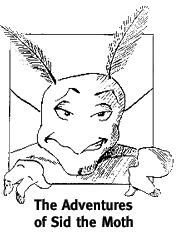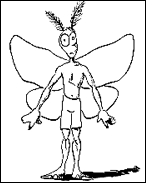
By AMY ADAMS
Illustrations by AUDRA LOYALMale coddling moths have a lot to worry about in this world, what with having to find apple, pear or walnut trees to infest, avoid farmers' pesticides, and finally find a mate. Their job got a little harder six years ago, when a UC Santa Cruz entomologist named Sean Swezey encouraged apple farmers to decorate their trees with alluring decoys. The devices confuse male moths, and prevent them from mating with females. No sex means no larvae, and no larvae means no little brown worms to surprise unsuspecting apple eaters.
This technique relies on the fact that male moths "smell" females with their antennae. Lusty male moths leave females waiting in the branches while they court a grey or red twist tie or shiny flap of aluminum covered in the sex scent females exude to attract males - called a pheromone. With 100 to 400 dispensers per acre, males are too overwhelmed by the scent of these sexy gadgets to find females and mate. They are adrift in an aromatic fog, searching in vain for expectant females. Imagine being in perfume factory trying to smell an individual person, and you may understand the plight of today's male moth.
In the ever-escalating battle between moths and men, or pests and farmers, this latest weapon of the farmer is called "mating disruption". Also called "male confusion", this technique has reduced damage from pests in a smorgasbord of fruits and vegetables including artichokes, strawberries, cherries, and almonds, and has successfully battled the coddling moth. It's easier than spraying, it's non-toxic, and it doesn't kill off beneficial insects - a big problem with chemical pesticides. Some "good" insects help pollinate or may be natural predators of coddling moths and other pests.
Coddling moth larvae are the most serious economic threat to apple orchards across the country. Their voracious tunneling leaves a tell-tale hole on the apple's surface, ruining an apple for future sale and costing farmers a percentage of their profit. The exact amount of profit loss varies wildly by geographic location and age of the orchard. Sean Swezey, head of UCSC's cooperative extension program, has a USDA grant to stop these larvae before they ever get started - by preventing mature moths from mating.
Mating disruption has kept damage from coddling moth larvae under control in orchards across the state. Steve Loyal, an apple farmer and agriculture biologist in Santa Ynez, CA, has two percent damage to his apples using mating disruption, and says, "The cost of losing that percentage is less than the cost of spraying." Loyal could acheive this level of control using chemicals, but on his farm mating disruption is both less costly and allows Loyal to sell his apples as "unsprayed"- a competitive advantage in the apple market.
Jim Rider, who farms organic apples in Watsonville, CA, has had a similar experience. "Mating disruption is now the best organic control available, both in terms of effectiveness and cost," Rider said. However, he can't estimate damage from coddling moths. "Every year and every block is different," he says. Mating disruption varies in efficiency by location and apple type, so it is impossible to predict exactly how effective it will be.
Mating disruption works best in densely planted orchards. The dense canopy traps pheromones near trees, and therefore near male moths. By the edges of orchards, or in windy, hilly, or "gappy" orchards, where pheromones may escape or be blown away, male moths may sniff out females amidst the thinner haze of pheromone. It is also more successful on early developing apples such as Gala, Jonagold, Gravenstien, or Red Delicious, which spend less time on the tree, and therefore have a smaller chance of feeding a hungry coddling moth larvae. But the technique isn't perfect. Even in closely planted orchards, males and females may bump into each other by sheer luck.
Mating disruption costs slightly more than conventional sprays. Farmers pay 75 to 100 dollars per acre per application with one to three applications a year. But Swezey says mating disruption could save in convenience what it loses in cost. For every application of every toxic spray, farmers are required to fill out forms reporting the chemical's use. Using non-toxic pheromones saves on paperwork and on labor, balancing out the cost increase.
"We hope to get the cost down to more encouraging levels," said Swezey. Then, he hopes, more farmers will be hindering amorous intentions of moths on their farms.
For more information on mating disruption call Sean Swezey at (408) 459-4367. 




